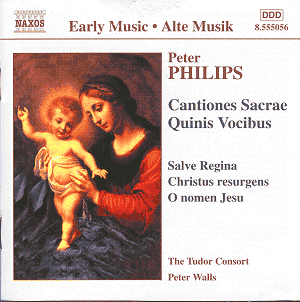It is remarkable that Peter Philips has not attained
the status now accorded to his contemporary William Byrd, to whom, during
the Counter-Reformation in England, he was considered an equally famous
composer of religious music, though Philips spent his later years in
the Netherlands and is, perhaps, better known as a composer for keyboards.
These five-part motets display all the originality,
passion and sophistication of Byrd, and the subtle "word painting"
that characterises much Italian 16th and 17th
century sacred music. Cantiones Sacrae is a title frequently
used from 1535 onwards for collections of similar works by composers
such as Byrd, Tallis and Thomas East. Their imitative polyphonic texture
calls for flexible forms in which successive voices spin out contrapuntal
lines in a complex and interesting manner, declamatory passages alternating
with independently developed themes closely associated with the Latin
texts (obligingly translated in the insert booklet).
The title page of the 1612 edition of the Cantiones
(published two years later than Monteverdis better-known Vespro
della Beata Vergine) states that these motets were "intended
for the principal parts of the whole year, and the common of the saints".
Unusually long for their period, they wonderfully display the burgeoning
of an English style that has moved purposefully away from the austere
polyphony of Palestrina towards the emotional intensity and colourful
harmonic spectrum of the early baroque period.
The Tudor Consort is completely at home with these
works, and the recording lives up to their subtle interpretations and
meticulous enunciation. The acoustic is not over-resonant, which helps
the listener follow the intricate weaving of the voices into a resplendent
tapestry of sound. Yet another important rescue operation by Naxos which
should earn the gratitude of early music enthusiasts.
Roy Brewer


